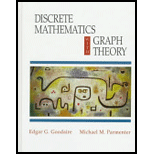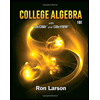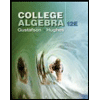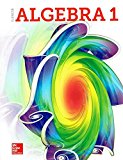
Discrete Mathematics with Graph Theory (Classic Version) (3rd Edition) (Pearson Modern Classics for Advanced Mathematics Series)
3rd Edition
ISBN: 9780134689555
Author: Edgar Goodaire, Michael Parmenter
Publisher: PEARSON
expand_more
expand_more
format_list_bulleted
Concept explainers
Textbook Question
Chapter 5, Problem 19RE
Define the Fibonacci sequence.
Is it possible for three successive terms in the Fibonacci sequence to be odd?
Is it possible for two successive terms in the Fibonacci sequence to be even?
Justify your answers.
Expert Solution & Answer
Want to see the full answer?
Check out a sample textbook solution
Chapter 5 Solutions
Discrete Mathematics with Graph Theory (Classic Version) (3rd Edition) (Pearson Modern Classics for Advanced Mathematics Series)
Ch. 5.1 - True/False Questions The statement i=1n(2i1)=n2...Ch. 5.1 - Prob. 2TFQCh. 5.1 - Prob. 3TFQCh. 5.1 - Prob. 4TFQCh. 5.1 - Prob. 5TFQCh. 5.1 - Prob. 6TFQCh. 5.1 - Prob. 7TFQCh. 5.1 - Prob. 8TFQCh. 5.1 - Prob. 9TFQCh. 5.1 - Prob. 10TFQ
Ch. 5.1 - Prob. 1ECh. 5.1 - Prob. 2ECh. 5.1 - Prove that it is possible to fill an order for n32...Ch. 5.1 - Use mathematical induction to prove the truth of...Ch. 5.1 - Prove by mathematical induction that...Ch. 5.1 - Use mathematical induction to establish the truth...Ch. 5.1 - 7. Rewrite each of the sums in Exercise 6 using...Ch. 5.1 - 8. Use mathematical induction to establish each of...Ch. 5.1 - 9. Use mathematical induction to establish the...Ch. 5.1 - Prob. 10ECh. 5.1 - Prob. 11ECh. 5.1 - Prob. 12ECh. 5.1 - Prob. 13ECh. 5.1 - Prob. 14ECh. 5.1 - Prob. 15ECh. 5.1 - Prob. 16ECh. 5.1 - Prob. 17ECh. 5.1 - Prob. 18ECh. 5.1 - Prob. 19ECh. 5.1 - Prob. 20ECh. 5.1 - 21. Prove the Chinese Remainder Theorem, 4.5.1, by...Ch. 5.1 - Prob. 22ECh. 5.1 - Prob. 23ECh. 5.1 - Prob. 24ECh. 5.1 - Prob. 25ECh. 5.1 - Prob. 26ECh. 5.1 - Prob. 27ECh. 5.1 - Prob. 28ECh. 5.1 - Prob. 29ECh. 5.1 - Given an equal arm balance capable of determining...Ch. 5.1 - Prob. 31ECh. 5.1 - 32. Let be any integer greater than 1. Show that...Ch. 5.1 - Prob. 33ECh. 5.1 - Prob. 34ECh. 5.1 - Prob. 35ECh. 5.1 - Prob. 36ECh. 5.1 - Prob. 37ECh. 5.1 - 38. For a given natural number prove that the set...Ch. 5.1 - 39. (a) Prove that the strong form of the...Ch. 5.1 - Prob. 40ECh. 5.1 - Prob. 41ECh. 5.2 - True/False Questions
If and for , then .
Ch. 5.2 - Prob. 2TFQCh. 5.2 - Prob. 3TFQCh. 5.2 - Prob. 4TFQCh. 5.2 - Prob. 5TFQCh. 5.2 - Prob. 6TFQCh. 5.2 - Prob. 7TFQCh. 5.2 - True/False Questions The Fibonacci sequence arose...Ch. 5.2 - Prob. 9TFQCh. 5.2 - Prob. 10TFQCh. 5.2 - Give recursive definitions of each of the...Ch. 5.2 - Find the first seven terms of the sequence {an}...Ch. 5.2 - Let a1,a2,a3,...... be the sequence defined by...Ch. 5.2 - Prob. 4ECh. 5.2 - Prob. 5ECh. 5.2 - Prob. 6ECh. 5.2 - Prob. 7ECh. 5.2 - 8. Suppose is a sequence such that and, for, ....Ch. 5.2 - Prob. 9ECh. 5.2 - Prob. 10ECh. 5.2 - Prob. 11ECh. 5.2 - Prob. 12ECh. 5.2 - Prob. 13ECh. 5.2 - Prob. 14ECh. 5.2 - Prob. 15ECh. 5.2 - Prob. 16ECh. 5.2 - Prob. 17ECh. 5.2 - 18. Consider the arithmetic sequence with first...Ch. 5.2 - Prob. 19ECh. 5.2 - Prob. 20ECh. 5.2 - Prob. 21ECh. 5.2 - Prob. 22ECh. 5.2 - Prob. 23ECh. 5.2 - Prob. 24ECh. 5.2 - Prob. 25ECh. 5.2 - Prob. 26ECh. 5.2 - Prob. 27ECh. 5.2 - Prob. 28ECh. 5.2 - Prob. 29ECh. 5.2 - Prob. 30ECh. 5.2 - Prob. 31ECh. 5.2 - 32. (a) Find the 19th and 100th terms of the...Ch. 5.2 - Given that each sum below is the sum of part of an...Ch. 5.2 - Prob. 34ECh. 5.2 - 35. Is it possible for an arithmetic sequence to...Ch. 5.2 - Prob. 36ECh. 5.2 - Prob. 37ECh. 5.2 - Prob. 38ECh. 5.2 - Prob. 39ECh. 5.2 - Prob. 40ECh. 5.2 - Prob. 41ECh. 5.2 - Prob. 42ECh. 5.2 - Prob. 43ECh. 5.2 - 44. Define a sequence recursively as follows:
...Ch. 5.2 - Prob. 45ECh. 5.2 - Prob. 46ECh. 5.2 - Prob. 47ECh. 5.2 - 48. Represent the Fibonacci sequence by , for...Ch. 5.2 - Prob. 49ECh. 5.2 - Prob. 50ECh. 5.2 - Prob. 51ECh. 5.2 - Prob. 52ECh. 5.2 - Prob. 53ECh. 5.2 - Prob. 54ECh. 5.2 - Prob. 55ECh. 5.2 - Prob. 56ECh. 5.2 - Prob. 57ECh. 5.2 - Prob. 58ECh. 5.3 - True/False Questions
The recurrence relation can...Ch. 5.3 - Prob. 2TFQCh. 5.3 - Prob. 3TFQCh. 5.3 - Prob. 4TFQCh. 5.3 - Prob. 5TFQCh. 5.3 - Prob. 6TFQCh. 5.3 - Prob. 7TFQCh. 5.3 - Prob. 8TFQCh. 5.3 - Prob. 9TFQCh. 5.3 - Prob. 10TFQCh. 5.3 - Solve the recurrence relation, , given .
Ch. 5.3 - Prob. 2ECh. 5.3 - Solve the recurrence relation, , given .
Ch. 5.3 - Solve the recurrence relation an+1=7an10an1, n2,...Ch. 5.3 - Prob. 5ECh. 5.3 - 6. Solve the recurrence relation, , given
Ch. 5.3 - 7. Solve the recurrence relation , , given .
Ch. 5.3 - 8. Solve the recurrence relation , , given ....Ch. 5.3 - 9. Solve the recurrence relation , , given ....Ch. 5.3 - 10. (a) Solve the recurrence relation , , given ....Ch. 5.3 - Prob. 11ECh. 5.3 - Prob. 12ECh. 5.3 - Solve the recurrence relation an=5an16an2, n2,...Ch. 5.3 - Prob. 14ECh. 5.3 - Prob. 15ECh. 5.3 - Solve the recurrence relation an=4an14an2+n, n2,...Ch. 5.3 - Prob. 17ECh. 5.3 - Prob. 18ECh. 5.3 - Prob. 19ECh. 5.3 - Prob. 20ECh. 5.3 - Prob. 21ECh. 5.3 - Prob. 22ECh. 5.3 - 23. The Towers of Hanoi is a popular puzzle. It...Ch. 5.3 - 24. Suppose we modify the traditional rules for...Ch. 5.3 - Prob. 25ECh. 5.3 - Prob. 26ECh. 5.3 - Prob. 27ECh. 5.4 - Prob. 1TFQCh. 5.4 - Prob. 2TFQCh. 5.4 - Prob. 3TFQCh. 5.4 - Prob. 4TFQCh. 5.4 - Prob. 5TFQCh. 5.4 - Prob. 6TFQCh. 5.4 - Prob. 7TFQCh. 5.4 - Prob. 8TFQCh. 5.4 - Prob. 9TFQCh. 5.4 - Prob. 10TFQCh. 5.4 - Prob. 1ECh. 5.4 - Prob. 2ECh. 5.4 - Prob. 3ECh. 5.4 - Prob. 4ECh. 5.4 - Prob. 5ECh. 5.4 - Prob. 6ECh. 5.4 - Prob. 7ECh. 5.4 - Prob. 8ECh. 5.4 - Prob. 9ECh. 5.4 - Prob. 10ECh. 5.4 - Prob. 11ECh. 5.4 - Prob. 12ECh. 5.4 - Prob. 13ECh. 5.4 - Prob. 14ECh. 5 - Use mathematical induction to show that...Ch. 5 - Using mathematical induction, show that
for all...Ch. 5 - Using mathematical induction, show that (112)n1n2...Ch. 5 - Prove that for all integers.
Ch. 5 - 5. Use mathematical induction to prove that is...Ch. 5 - 6. Prove that for all.
Ch. 5 - Prob. 7RECh. 5 - 8. (a) Give an example of a function with domaina...Ch. 5 - Give a recursive definition of each of the...Ch. 5 - Guess a simple formula for each of the following...Ch. 5 - 11. Consider the sequence defined by and for. What...Ch. 5 - 12. Find the sum.
Ch. 5 - 13. Let be defined recursively by and, for , ....Ch. 5 - Define f:ZZ by f(a)=34a, and for tZ define a...Ch. 5 - Consider the arithmetic sequence that begins...Ch. 5 - 16. The first two terms of a sequence are 6 and 2....Ch. 5 - 17. Let be the first four terms of an arithmetic...Ch. 5 - Explain why the sum of 500 terms of the series...Ch. 5 - 19. (a) Define the Fibonacci sequence.
(b) Is it...Ch. 5 - Show that, for n2, the nth term of the Fibonacci...Ch. 5 - Let f1,f2,....... be the Fibonacci sequence as...Ch. 5 - Suppose you walk up a flight of stairs one or two...Ch. 5 - 23. Solve the recurrence relation given that and...Ch. 5 - Solve Exercise 23 using the method of generating...Ch. 5 - 25. Find a formula for, given and for .
Ch. 5 - Let an be the sequence defined by a0=2,a1=1, and...Ch. 5 - Prob. 27RECh. 5 - Prob. 28RECh. 5 - Prob. 29RECh. 5 - 30. (For students of calculus) Let denote the...
Knowledge Booster
Learn more about
Need a deep-dive on the concept behind this application? Look no further. Learn more about this topic, subject and related others by exploring similar questions and additional content below.Similar questions
- The 8th term of an arithmetic sequence is 25, and the 12th term is 41. Write the first 11 terms of this sequence.arrow_forwardThe second term of a geometric sequence is 6, and the fifth term is 81/4. Find the eighth term. (Assume that the terms of the sequence are positive.)arrow_forwardThe second term of a geometric sequence is 14, and the sixth term is 224. Find the nth term. (Assume that the terms of the sequence are positive.)arrow_forward
- Find a formula for the nth term of the geometric sequence 4, 20, 100, . . . .What is the 12th term of the sequence?arrow_forwardThe 5th term of an arithmetic sequence is 45, and the 12th term is 24. Find the nth term.arrow_forwardFind the missing term in each arithmetic sequence. If the 5th term of an arithmetic sequence is 14 and the second term is 5, find the 15th term.arrow_forward
arrow_back_ios
arrow_forward_ios
Recommended textbooks for you

 College Algebra (MindTap Course List)AlgebraISBN:9781305652231Author:R. David Gustafson, Jeff HughesPublisher:Cengage LearningAlgebra & Trigonometry with Analytic GeometryAlgebraISBN:9781133382119Author:SwokowskiPublisher:Cengage
College Algebra (MindTap Course List)AlgebraISBN:9781305652231Author:R. David Gustafson, Jeff HughesPublisher:Cengage LearningAlgebra & Trigonometry with Analytic GeometryAlgebraISBN:9781133382119Author:SwokowskiPublisher:Cengage Glencoe Algebra 1, Student Edition, 9780079039897...AlgebraISBN:9780079039897Author:CarterPublisher:McGraw Hill
Glencoe Algebra 1, Student Edition, 9780079039897...AlgebraISBN:9780079039897Author:CarterPublisher:McGraw Hill


College Algebra (MindTap Course List)
Algebra
ISBN:9781305652231
Author:R. David Gustafson, Jeff Hughes
Publisher:Cengage Learning

Algebra & Trigonometry with Analytic Geometry
Algebra
ISBN:9781133382119
Author:Swokowski
Publisher:Cengage

Glencoe Algebra 1, Student Edition, 9780079039897...
Algebra
ISBN:9780079039897
Author:Carter
Publisher:McGraw Hill

Sequences and Series Introduction; Author: Mario's Math Tutoring;https://www.youtube.com/watch?v=m5Yn4BdpOV0;License: Standard YouTube License, CC-BY
Introduction to sequences; Author: Dr. Trefor Bazett;https://www.youtube.com/watch?v=VG9ft4_dK24;License: Standard YouTube License, CC-BY